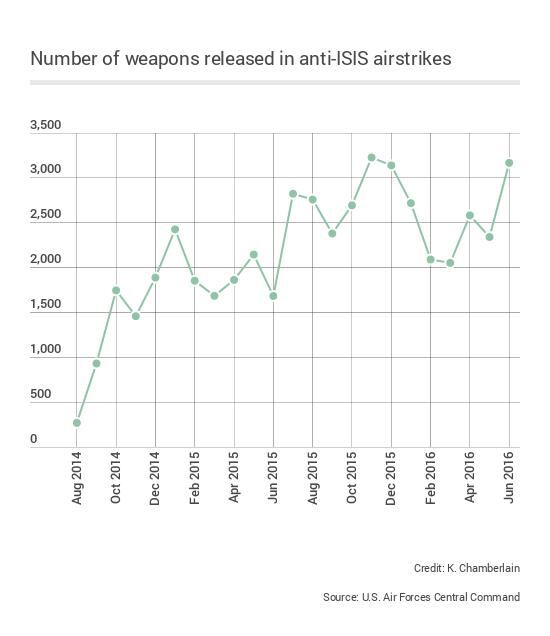Airstrikes against the Islamic State group in Iraq and Syria last month surpassed 3,000 weapons dropped for the first time since 2015, according to the latest statistics from U.S. Air Forces Central Command.
The Air Force in June worked round the clock to support allied ground forces on three fronts — Fallujah and Mosul in Iraq, and Raqqa in Syria — to diminish the Islamic State stronghold in each location. For such campaigns, dispatching air support well ahead of a ground fight has been a critical maneuver in advancing the air war against the extremist group, the head of AFCENT said in late May.
"The model that we use ... in the combined joint operating area, as the air component, we're able to strike ahead of the ground movement, so that's my goal," said Lt. Gen. Charles Brown, the head of the air war against the Islamic State group, which is also known as ISIS or ISIL.
"If I know where the next fight's going to be, then what I want to be able to do is actually soften up that with strikes. ... And we found that if we do that, the resistance that the ground forces face seems to be less for a number of reasons," Brown said.
The service's air campaign against ISIS has remained fairly steady over the past year, with the total number of weapons employed hovering around 2,500 a month.
There was an uptick between November and December when the U.S. and its allies increased their targeting of the militant group following the Nov. 13 terrorist attacks in Paris, which killed 129 people. For the first time under Operation Inherent Resolve, the Air Force dropped more than 3,100 bombs and missiles during that time.
In Afghanistan, strikes are on a steady incline, according to AFCENT statistics for Operations Freedom's Sentinel and Resolute Support, the Pentagon and NATO names for the campaigns.
Defense officials approved new rules to strike the Taliban in June, which gives U.S. commanders expanded authority to call in aerial backup for Afghan and U.S. forces on the ground. Afghanistan has seen recent increases in both ISIS and Taliban fighters.
The number of weapons released last month was just shy of 100; in January and February, the service released roughly 120 weapons, the most ordnance dropped during the winter months since 2013.
The move in Afghanistan mimics the U.S. approach toward the air war against the Islamic State, where commanders have much more latitude to decide which targets to go after.
Defense officials in April announced changes are on the way for how airstrikes over Iraq and Syria are approved, giving ground commanders direct authorization for a "rapid execution of strikes."

Oriana Pawlyk covers deployments, cyber, Guard/Reserve, uniforms, physical training, crime and operations in the Middle East and Europe for Air Force Times. She was the Early Bird Brief editor in 2015. Email her at opawlyk@airforcetimes.com.




